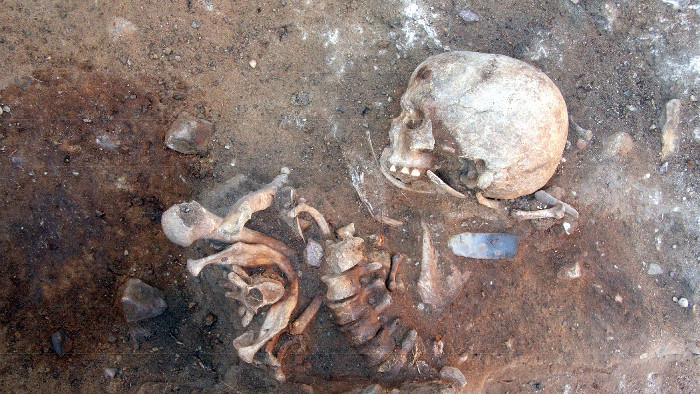Discovered the 7,000-year-old remains buried in strange posture
A set of 7,000-year-old remains was discovered in the Mesolithic area, Germany, buried in a strange position, never discovered.
Accordingly, the 7,000-year-old remains belong to a young, upright posture buried near the village of Groß Fredenwalde, northeastern Germany. The young man's body was placed in a vertical pit. The body is fixed vertically using sand filled from the bottom to the knee. The upper part of the damaged, not intact remains.
Dating back to 8,500 years, the area that discovered the remains buried in this strange position belonged to the Mesolithic period when people in Europe at that time lived by hunter-gatherers and rarely stayed in a fixed place. determined.

The 7,000-year-old skeleton remains buried in a strange posture in an 8,500-year-old cemetery.
According to Thomas Terberger - the excavation director of the Lower Saxony Cultural Heritage Department, the Mesolithic is one of the first cemeteries in Europe used by central Europeans. This community has hunted and caught fish around 6400 BC - 500 BC.
The Terberger director said the remains of the young man buried in an upright position were the only bones buried in a strange letter discovered in Central Europe.
Based on the arrangement of the bones, the researchers speculated that the young dead man was placed in a vertical pit with a height of more than 1.5 meters.
Since the discovery of this archaeological area, 9 human remains have been unearthed by experts. Among them are 5 remains of 6-year-old children and 1 set of 8,400-year-old babies with arms in front of their chests.
- Discovered the 2,000-year-old remains of 'Sleeping Beauty in the Forest' in Ethiopia
- The 5,000-year-old fist couple remains in Russia
- Discovered the 5,000-year-old homosexual remains
- Hundreds of years old turned on the original reveal the medieval remains
- Detecting the remains of 'hug each other without leaving' for 6,000 years
- Marvel at the remains of strange creatures with human legs and gibbon arms
- Discovered a 3,500-year-old male and female skeleton in the fist position
- Which posture is good for women?
- Benefits when keeping the body in the correct posture
- Rediscover the 6,500-year-old remains
- Detecting strange UFO-shaped objects buried deep underground in Russia
- The 4,000-year-old couple is in a close posture in an ancient tomb full of gold
 Discovered an ancient centipede fossil 99 million years old
Discovered an ancient centipede fossil 99 million years old Discovered bat-like dinosaurs in China
Discovered bat-like dinosaurs in China Discovered a 200-year-old bronze cannon of the coast
Discovered a 200-year-old bronze cannon of the coast Discover 305 million-year-old spider fossils
Discover 305 million-year-old spider fossils